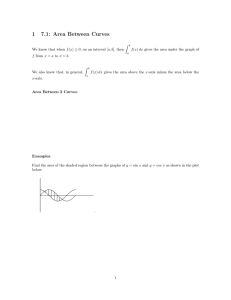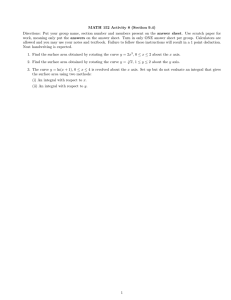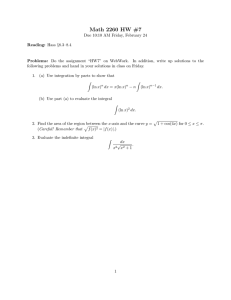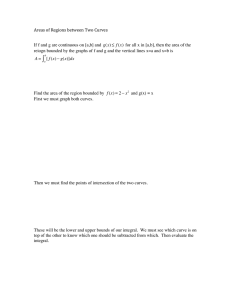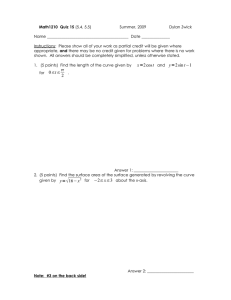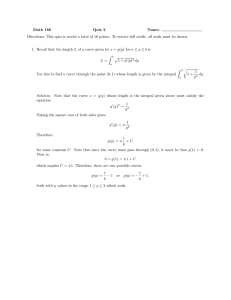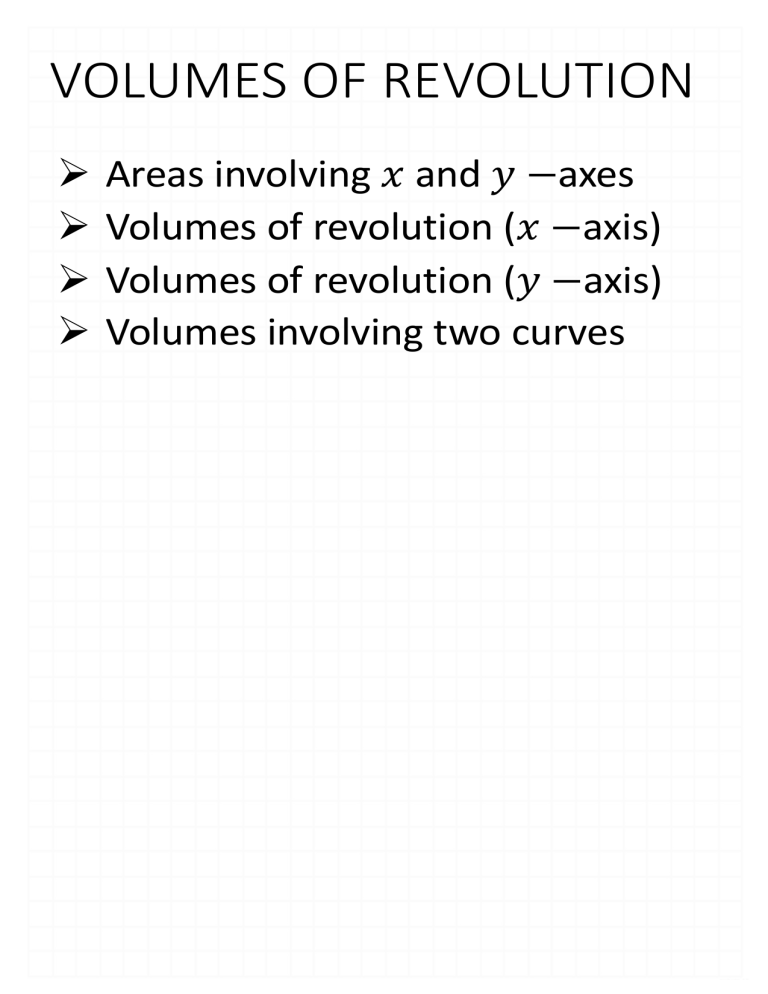
VOLUMES OF REVOLUTION Ø Ø Ø Ø Areas involving ! and " −axes Volumes of revolution (! −axis) Volumes of revolution (" −axis) Volumes involving two curves Warm Up The graph shows the speed at which an object travels over time. a) Find the distance it travels in: i. 1s 30 m ii. 2s 60m iii. 3s 90m b) Find the area under the line between: i. t = 0 and 1 30 units ii. t = 0 and 2 60 units iii. t = 0 and 3 90 units a) The speed is a constant 30 metres per second (m/s) i. The object travels 30 metres in 1 s ii. The object travels 60 metres in 2 s iii. The object travels 90 metres in 3 s b) i. The area is 30 x 1 = 30 units2 ii. The area is 30 x 2 = 60 units2 iii. The area is 30 x 3 = 90 units2 The area gives the distances. LINK The line graph gives a rate of change. The area under the curve gives the information about the original data for this rate of change. Thus , the area under a rate of change curve gives the original data. The original data is the primitive function of the curve. Applications of Integration Ø Distance, Velocity and Acceleration Ø Volumes Ø Physics - Work, Centre of Mass, Kinetic Energy Ø Probability Ø Arc Length, Surface Area THE DEFINITE INTEGRAL The diagram below shows the region contained between a given curve ! = #(%) and the % −axis, from % = ( to % = ), where ( ≤ ). In the diagram, below, the region has been dissected into a number of thin strips. Each strip is approximately a rectangle, but only roughly so, because the upper boundary is curved. The area of the region is the sum of the area of all the strips. Let the width of the one of the strips be +%, where +% is thought as being very small. Area of strip~height × width ~# % +% Adding up all the strips, using sigma notation for the sum. $ Area of shaded region~ = (area of each strip) !"# $ ~ = # % +% !"# INTEGRAL NOTATION We can approximate the area under the curve using a large number of rectangles by making the width of each rectangle very small. Taking an infinite number of rectangles, !" → 0 As !" → 0, the sum of rectangles → exact area Area = lim - .(") !" !"→$ = 1 .(") !" NOTE: The symbol ∫ is an old form of the letter S and is used to suggest an infinite sum under a smooth curve (sum of rectangles). We call ∫ "($) &$ an indefinite integral. If we are finding the area under the curve " = $ % between % = & and % = *, we write: " + $(%) .% ! " We call ∫! $(%) .% a definite integral. FUNDAMENTAL THEOREM OF CALCULUS The area enclosed by the curve ! = #(%), the % − axis and the lines % = ( and % = ) is given by: " * # % +% = , ) − ,(() ! Where ,(%) is the primitive function #(%) Area and the Integral Regions above the x-axis have p_________ Ositive signed area. Regions below the x-axis have n_________ signed area. egative Suppose #(%) ≥ 0 in the domain % ∈ (, ) . Then ( ∫' "($) &$ yields the a________ between the curve and re a the _______ axis. ( Calculating ∫' "($) &$ yields the s_________ are igned enclosed by the graph of ! = #(%) and the x-axis in the domain % ∈ [____, a ____ b ] If #(%) is below the x-axis for % ∈ (, ) will be n__________. egative ( then ∫' "($) &$ Area Under A Curve The diagram below shows the graph of " = $ % . Let 0, 2, 3 and 4 represent the positive area of their corresponding regions. The regions with a positive signed area are __________ R and the and P regions with a negative signed area are ______. Q S ! S ∫% "($) &$ will calculate 0 − 2 + 3_______. The area of the region enclosed by $ % and the x-axis where % ∈ 9, . is __________. de or feddel I The total area between the $ % and the x-axis is __________. Iffce ptQtrts When finding the area of a region, you should produce a s________ ketch of the region first. This is so then you can see fi there are any “areas” b_______ ebwe the x-axis that you have to make positive. However, if the function is clearly p_________ in the domain of osibre integration, then a s_________ is not necessary. ketch If the function is o_______ or e________, use symmetry whenever ven dd possible to make it easer to find the area. QUESTION 1 By first sketching the following graph, find the area of the region bounded by the curve and the x-axis. ! =2−%−% E t 2 E Ze te t 2 # e eat 2 trcetz Ceti l e Getz Getz if I e E de 2 Ee E E 2 4 2 1 1 I f 5 Itf 7 80 units QUESTION 2 a) Find the area of the region bounded by $ % = % # − 8% $ + 15% RE 8 f 1 15 eco 3 Ce 5 j 63g t & 63 t + $(%) .% 12,52 ft t 10031 373 81 2 632 f's 634 163 % o Is E I 213 132 b) Calculate f 3 85 15e de 3 L sN 18 3 8 4156de t 2572 4 853 151 85 15 de 14 10030 373 12,52 c) Explain briefly how your answer in (b) implies that the region where % ∈ 0, 3 is larger than the region where % ∈ 3, 5 The netsignedarea more positive area e de is positive so theremust have been than negative area 1321 QUESTION 3 Consider the shaded region below: Write down and evaluate the integral that represents the shaded region by considering the region bounded by the curve and the a Crore and y p Y f e axis y or y y dy a) " −axis y O 8 3g b 12 units 16 Curveand e axis y p b) % −axis when y 8 2 8 is 16 I6 8 8 V8 2 Je de ET 4025 4 12 units QUESTION 4a Find the area of the following region bounded by " = 2 ln % + 2 and both axes. y 2 InCet2 y InCatz Getz e I eth eY Catz et 2 e I e e k e 2 2 dy Ezek 2g Re 26 20 263 26m43 244 2 2 244 I 2 2 2h22I 442 4h 2 2 QUESTION 4b Find the area of the following shaded region: " = tan'( % for % ∈ 0, 1 y tan Ceti etr tang tang I e glory 0 Ig e dy day Choosel y q fantasy flat In 2 in 2 I k If finccoso o fines g If In 2 units QUESTION 4c Find the area of the following shaded region: " = 3 sin'( ) $ for % ∈ 0, 2 y 3 sun E Ate 2 y y y y 3 3 sit 355 CD 3 52 342 E n F site sun 8 13 25th 31 342 Jang dy 2 o 6 34 cosy 34 cos 34 6cost 605 353 6 0 6 3T1 31 6 units z QUESTION 5 By drawing a sketch and shading the appropriate region, evaluate the following integral. $ + ln % .% ( 2 42 e I s is n d 4 y Ine Leine e e eY Exinz 242 Jey dy Ey eh 21h2 2 242 242 p I so 1 i AREA UNDER TWO CURVES If $ % and D(%) are two continuous functions such that $(%) ≥ D(%) for all % ∈ &, * , then the area of the region bounded by the two areas in the domain % ∈ &, * is given by: " fld g F = + … … … … … e… . .% ! If you are asked to find the area enclosed by two curves, without being given any bounds, it means that you are required to first find the points of i___________ of intersection , and those will be your l_________ in its integration. !" − @ # % +% !! )" )# )" )$ + D % .% − + $ % .% − + $ % .% + + $ % .% )! )! )$ )" )# )" + D % .% − + $ % .% )! )! )" + D % − $ % .% )! A + −C = A − −C A+C =A+C QUESTION 6 7C Mo 09 15,8 & The diagram below shows a sketch of ' = 8$ − 7 − $ and ' = $ & − 4x + 3 a) 64 Find their point of intersection. 8 7 5 25 12 410 0 E Get 5 0 5 x 5 4 where 1 Where S CX 17 0 r0 does e 3 y y 867 7 865 7 45 0 65 8 and 5,8 b) Hence, find the area of the region between the two curves. 8 7 5 624 3 de r J 2 712 10 de Ets we 50 253 150 33 6 250 100 33 th 104 0 2431 64 a 2 Y units QUESTION 7 The curves " = % and % = 8" − " $ are drawn below. a) Find where the curves intersect. b) Find the area of region A. c) Find the area of region B. Region y y y0 y 71 yCy 77 At 1 0 e only 7 b O or 7 y 0 I 90 a Region A Ex 7 7 t Foy 4ft ay I Rft 48551 41 t 52 60 161 196 343 16g a 28 t y dy 44573 60 5131343 492 41 256 1889 j 0 units B fly 9 y 161 185 833 161 256 533 161 343 or 571units had QUESTION 8 The curves % = " + 5 and % = −" $ − 6" − 5 are drawn below. Find the area of the shaded region. yes y 2 Cytz Cyt5 y y I gg 19 f 5 6 1235 5 17 50 0 or y Cyts dy 2 14 20 I 2 y ioay I IF units Gy 5 5 10 0 y't74 I by so 5 HOMEWORK SEE WORKSHEET AND FOR EXTRA PRACTICE ON INTEGRATION (EX 5G)
